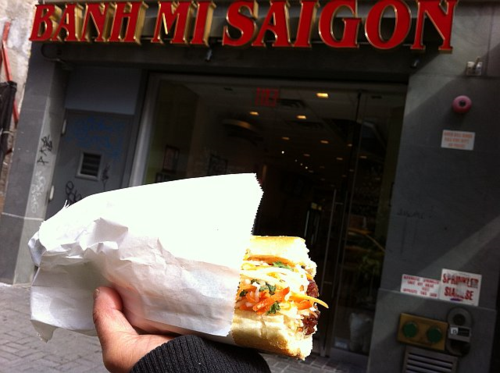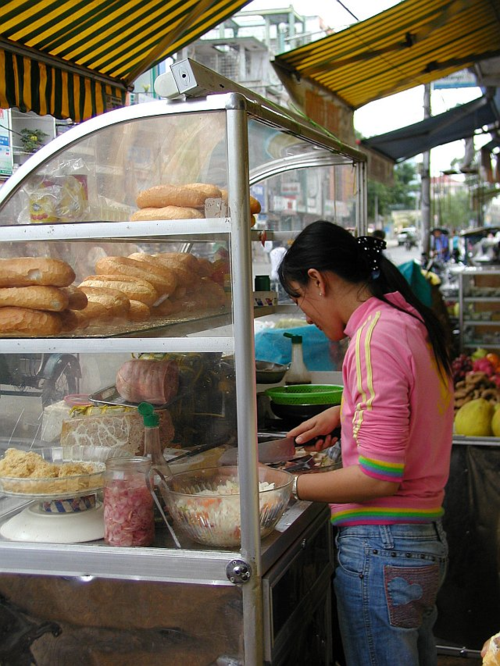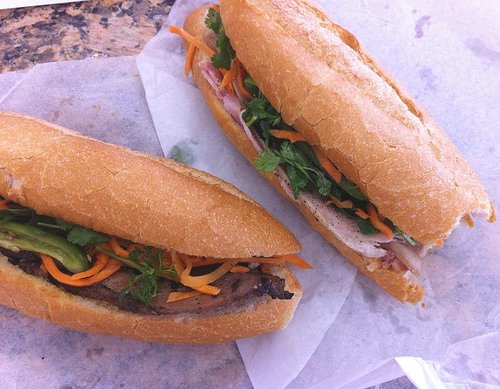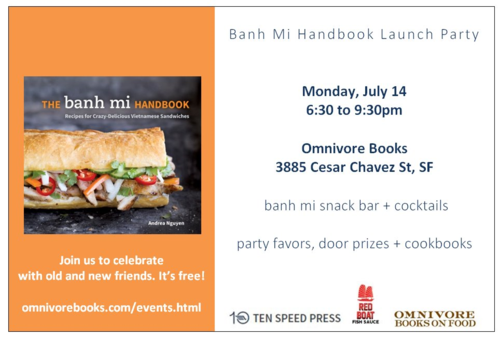Whenever I explore the streets of Vietnam and Little Saigon neighborhoods, a thousand tasty snacks beckon. Sticky rice with coconut, tropical fruit smoothies, and deep-fried dumplings vie for my attention, but I inevitably give in to an itinerant banh mi vendor with his or her wares beautifully displayed or a bustling Vietnamese bakery or deli advertising the sandwiches. I step up to the cart or counter and say, “Mot o banh mi dac biet” to order one sandwich with the works.
The dac biet originated in and around Saigon, the city where I was born. Friends of my father recall seeing the dac biet around the early 1940s in Saigon. It was a delicous, exciting street food to them back then as it is to me today.
For about a dollar in Vietnam and less than a bowl of pho abroad, I get to ingest Vietnamese history and culture. The bread, condiments, and some of the meats are the legacy of French and Chinese colonialism but in its entirety, the beloved and ubiquitous banh mi is 100 percent Viet. Adopting and reinventing foreign foodways is part of the amalgam that defines Vietnamese cuisine. Banh mi beautifully melds East and West, as evidenced by the unusual juxtaposition of ingredients that go into each sandwich.
After acknowledging my request, the sandwich maker slashes open a crisp baguette, moistens it with a lick of fresh mayonnaise and seasons it with a drizzle of soy sauce; if it’s a fancy operation, they’ll use Maggi Seasoning Sauce, a European umami-laden condiment that lends savory notes like that of soy sauce but is more intense.
Then the featured protein element goes in. It can be a single item, such as grilled pork or roast chicken, but my favorite is the classic known as the dac biet (the special). That’s essentially the works, a smearing of garlicky pork liver pate and thin slices of Vietnamese cold-cuts -- such as silky, mortadella-like gio lua sausage, crunchy headcheese that appears marblelike, and chewy-tender pork shank that often sports a pinkish red rind.
It’s an amazing combination of earthy and bright flavors, fatty and lean textures that showcase Vietnamese charcuterie. Some sandwich makers prepare their own array of meats while others source the best locally available renditions.
Next, the baguette gets filled with tangy daikon and carrot pickles, spicy chile slices, refreshing cucumber strips and pungent cilantro sprigs. It’s practically a salad. These vegetables counter the meats with their vibrant flavor, crunchy texture and cheery color. You don’t have to include them all, especially if you are not a heat seeker, but I typically go for the whole shebang for a raucous-yet-harmonious combination. The finished banh mi is wrapped in plain paper and secured with a rubber band. After money and sandwich exchange hands, I dive in.
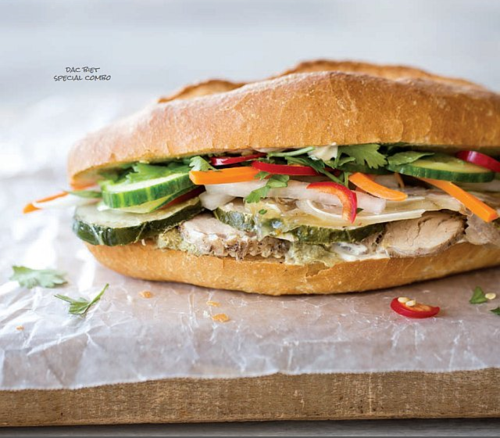
I’ve eaten many banh mi sandwiches crafted by pros and of course, made a bunch at home. Regardless of sourcing and filling (dac biet and others), my expectations are always met at the first bite. The delicate baguette shatters to give way to the eggy mayonnaise and hit of soy that are then followed by the layers of rich protein and crunchy vegetables.
Banh mi is pure synergy in the mouth, a quintessential Vietnamese street food experience that’s best eaten immediately. It’s instant gratification, as a good sandwich should be.
The Banh Mi Handbook comes out on Tuesday, July 8. Join me to make and create a bunch of tasty Vietnamese sandwiches!
And if you're in the Bay Area, we're having a party:
Related info:
- Pre-order gift & giveaway: The days are dwindling but you can still claim one, get your hands on rare Red Boat umami salt and other goodies
- Banh Mi Handbook in WSJ and Sample Recipes
- KFC Parent Company Launching a Banh Mi Shop in Texas
- Savoring Saigon's Best Banh Mi













